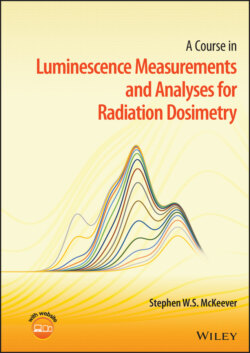Читать книгу A Course in Luminescence Measurements and Analyses for Radiation Dosimetry - Stephen W. S. McKeever - Страница 23
1.3.2 Medical Dosimetry
ОглавлениеTissue equivalence is also a desirable characteristic of dosimeters used in medical dosimetry, but not an essential property. The high sensitivity of the TL, OSL, and RPL processes can be exploited in medical dosimetry applications since the dosimeters can be made small, which in turn gives them the property of high spatial resolution. This, in turn, means that they have the potential for dose measurement in regions of severe dose-gradients.
Modern advances in radiation medicine – in radiodiagnosis, radiotherapy, and interventional radiography – are now presenting dosimetry challenges that did not exist previously. For example, the movement toward the use of charged particles (protons and carbon ions) in radiotherapy has resulted in new requirements for luminescence dosimeters compared to the dosimetry of high-energy photons. Known responses to charged particles means careful calibration of the dosimeters in charged-particle fields. This consideration becomes especially significant beyond the Bragg peak for energy deposition by charged particles. Here, the linear energy transfer (LET) of the particles increases rapidly as the particles lose energy and slow down. Knowledge of the behavior of dosimeters in such regions, where the physical dose is rapidly decreasing but the relative efficiency of biological damage (compared to high-energy photons) is rapidly increasing, is a research area of growing importance. Secondary neutron production is also a feature of charged-particle irradiation and the response of the dosimeter in neutron fields also needs to be established.
Sophisticated intensity-modulation techniques in radiotherapy, whether using photons or particles, also create new challenges for dosimetry. This is due to the production of sharp dose gradients where the therapists try to protect healthy tissue surrounding the tumor as much as possible. It is also necessary to understand the response of the dosimeter in either steady or rapidly pulsed radiation fields.
The luminescence dosimeters may be used in vivo or ex vivo. Their small size enables their innovative use internally as the patient is treated (for example, in brachytherapy). The dosimeters may also be used externally to measure entrance and exit doses on the surface of the patient without disturbance of the radiation field.
Luminescence (particularly OSL) has also been used as an imaging technique in radiodiagnosis (where it has long been known by its alternate name of photostimulated luminescence, PSL). The sensitivity and speed of readout of the stimulated luminescence signal has given radiologists the ability to reduce radiation doses to patients and yet provide high-resolution images to aid diagnosis. However, the use of OSL in this way is not dosimetry. The actual dose to the patient is still determined by other methods.
In interventional radiography the real-time dose to patients (and surgeons) during surgical procedures can be significant. Adaptation of OSL techniques using fiber optics can provide dose measurements in real time, without disturbing the x-ray image.
In all of the above applications, the preferred properties of the needed dosimeters include tissue equivalence, high sensitivity, small size, rapid response, and known responses as functions of dose, angle, photon energy, particle LET, and neutrons.
